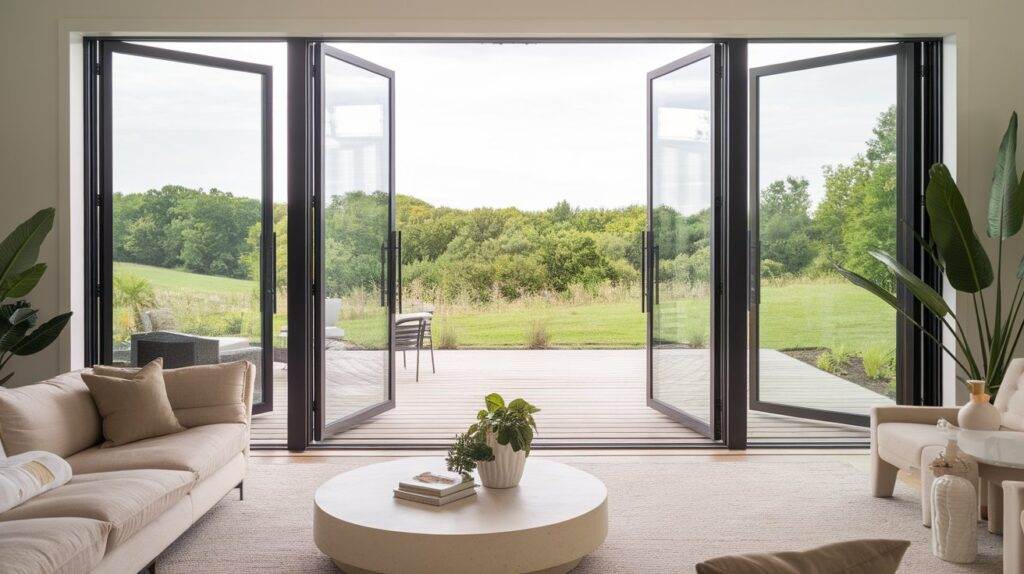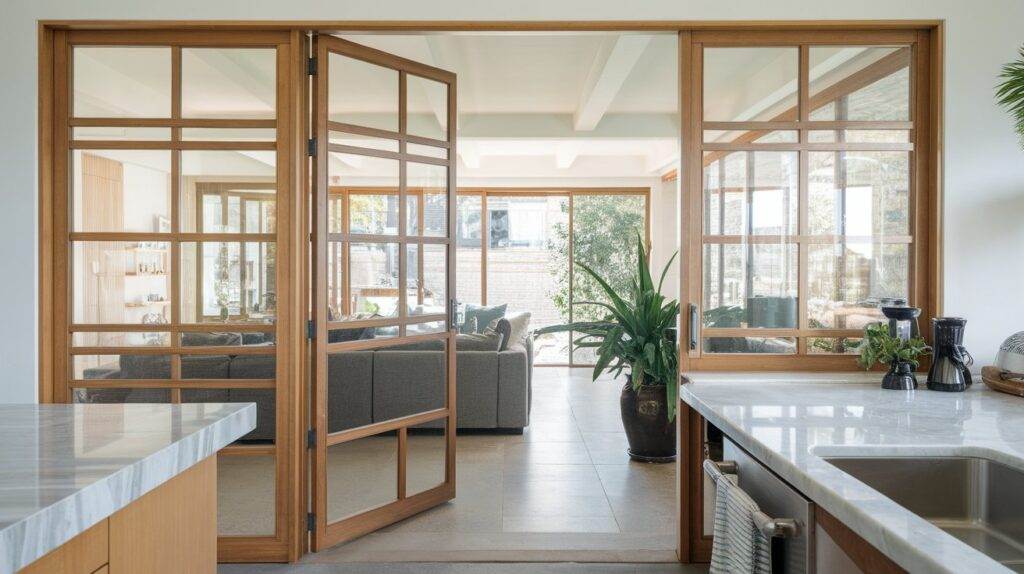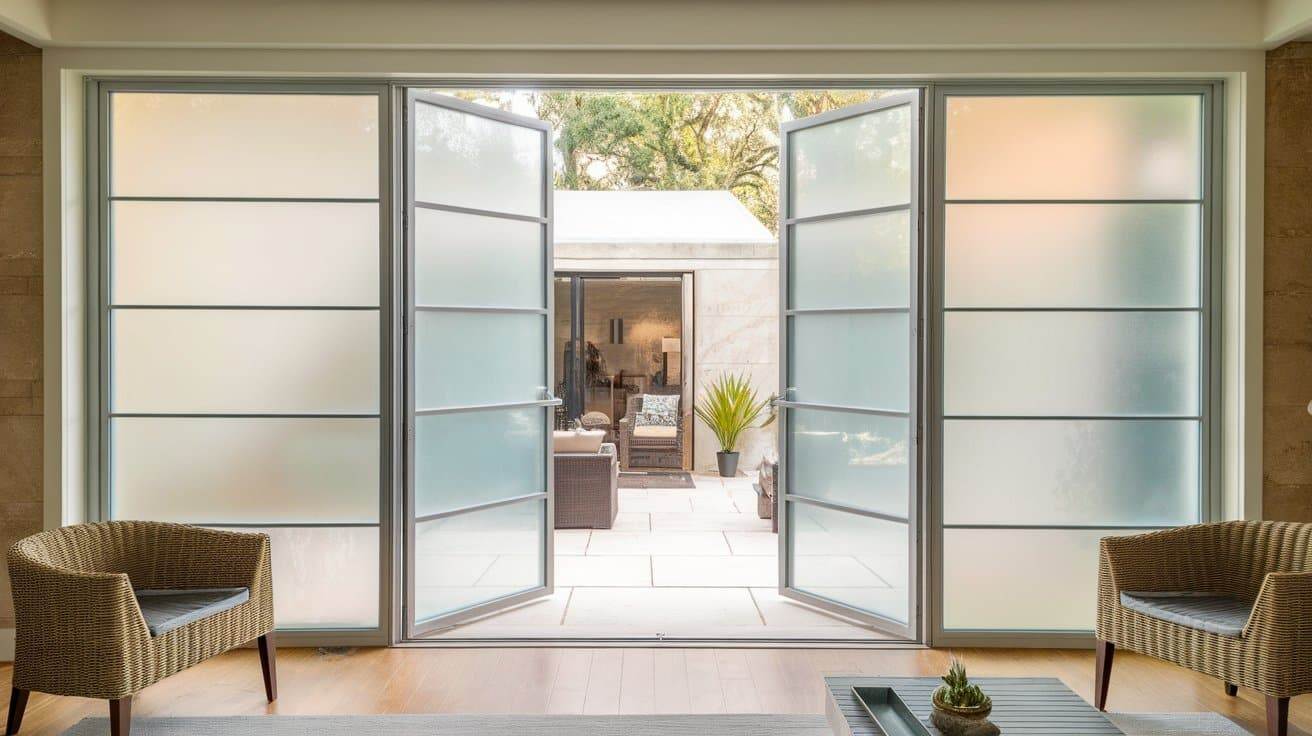Understanding the different types of bifold doors, exploring various bifold door styles and variations that suit modern homes. Learn about the top trends and innovations in folding doors for the upcoming year.
Types of Bifold Doors
Bifold doors are super popular in modern UK homes because they look great and can be really useful. Knowing the different types out there helps homeowners pick what works best for them.
Folding, Sliding, and Stacking Bifold Doors
Folding bifold doors fold back on themselves when you open them. They’re perfect for making a space feel bigger and connecting indoor areas to outdoor ones. You get a big opening that lets in lots of light.
Sliding bifold doors work on a track, so they slide open without taking up extra room. This makes them great for smaller spaces where you want to save every bit of space. Stacking bifold doors let you stack multiple panels at one or both ends, giving you control over how much space to open up.
Advantages include:
- Space Optimization: They create a large opening that improves flow between rooms.
- Natural Lighting: Big glass panels bring in plenty of light.
- Versatility: Good for homes and businesses alike.
But there are some downsides too, like the tracks can wear out over time and they need regular care to keep working smoothly.
Internal Bifold Doors
Internal bifold doors are great as room dividers. They give you privacy while still keeping things open. This is especially helpful in smaller homes where every bit of space counts.
Benefits include:
- Flexible Layouts: You can easily separate or connect rooms based on what you need.
- Light Enhancement: Glass panels help brighten up spaces without losing privacy.
When picking internal bifold doors, think about materials like wood or glass that match your home’s style. The right material not only looks good but also lasts longer.
External Bifold Doors
External bifold doors are awesome for linking indoor living areas with outdoor spots like patios or gardens. They’re built tough to handle weather while keeping your home safe and warm inside.
Key points include:
- Materials Used: Aluminum is strong, while uPVC is easy to maintain.
- Glazing Options: Double or triple glazing helps with energy use and cuts down noise from outside.
When choosing external bifold doors, check their insulation properties and security features like multi-point locking systems to keep your home secure while looking stylish. Also, make sure they fit well during installation for the best performance.
Understanding the different types of bifold doors—like folding, sliding, and stacking—along with their uses indoors and outdoors helps you make a smart choice that fits your home’s design needs perfectly!
Choosing the Right Bifold Door Style
When you’re picking a bifold door style for your home, think about how you want it to look. There are many bifold door styles out there. You can go for modern bifold doors with clean lines and simple frames, or you might like traditional bifold doors that have fancy details and wooden finishes. Knowing the different types helps you choose what fits best with your home’s vibe.
One big choice is whether to get solid or glazed panels. Solid panels give you privacy and keep the heat in, which is great for rooms where you want some alone time. Glazed panels, on the other hand, let in lots of light and make a space feel open and airy. So, think about what works with your design ideas and the mood you want to create.
Popular Bifold Door Panel Designs
There are some really cool panel designs for bifold doors that suit different tastes:
- Classic Bifold Panels: These are always in style! They fit well with both modern and traditional homes. People love them because they look good and work great.
- Vertical Bifold Panels: If you’ve got a tight space but lots of height, these are perfect! They draw your eyes up, making small rooms feel bigger.
- Concertina Style Bifold Panels: This design lets multiple panels fold back against each other, saving space while giving easy access.
Each design has its own perks when it comes to how they work and how they look. So think about which one fits best in your home!
Custom Bifold Door Features
Custom features can really boost how well your bifold doors work:
- Access Doors: Adding access doors means you can get in without opening all the panels. This is super handy if you’re always moving around!
- Toplights and Sidelights: These extra pieces let more natural light come in while keeping things private inside. Plus, they add a nice touch to how your doors look.
- Powder Coating: This finish makes your doors tough while letting you pick from lots of colors that match your style perfectly. It also helps protect against weather damage so they’ll stay looking good over time.
Think about these custom options when planning to install your new bifold doors! They’ll help make sure everything works just right for you while adding beauty to your space.
Advanced Materials and Technologies in Bifold Doors
Bifold doors are a great choice for many homes. They not only look good but also work well. The materials used in these doors can really change how they perform and how long they last. Let’s take a closer look at the different types of bifold doors available today.
Aluminum Bifold Doors
Aluminum bifold doors have a modern and sleek design. They are lightweight but very strong, making them a favorite among homeowners. One big plus is that aluminum doesn’t rust, so it can handle tough weather without falling apart. Plus, they don’t need much upkeep, which is always a win.
Wooden Bifold Doors
Wooden bifold doors bring a cozy feel to any space. They are loved for their natural beauty and can be customized to match different home styles. However, wooden doors do need some care over time to keep looking nice. Regular painting or staining helps protect them from moisture and sun damage.
uPVC Bifold Doors
If you’re looking for something budget-friendly, uPVC bifold doors are a smart pick. These doors offer great insulation, keeping your home warm in winter and cool in summer. uPVC is also tough against fading and warping, so you can enjoy your investment for years with little maintenance.
Thermal Efficiency
When choosing bifold doors, thermal efficiency matters a lot. This means how well the door keeps heat inside your home or outside when it’s hot out. Look for options with double or triple glazing; these features help reduce heat loss significantly. Better thermal performance not only helps the environment but also lowers energy bills.
Smart Bifold Doors and Home Automation
Smart technology is changing how we use our homes, including bifold doors. Smart bifold doors come with cool features that make life easier.
Remote Control and Connectivity
With smart bifold doors, you can control them from anywhere using your smartphone or even voice commands through systems like Amazon Alexa or Google Assistant. This means you can check on your entrance no matter where you are!
Enhanced Security Features
Many smart bifold systems include sensors that tell you when the door opens or closes. Automated locking systems add extra safety by ensuring your door locks itself after closing.
Sustainability in Bifold Door Design
Sustainability is becoming more important when designing modern bifold doors.
Eco-Friendly Materials
More manufacturers are using eco-friendly materials like recycled aluminum or wood from sustainable sources to make bifold doors. These choices help reduce harm to the planet while appealing to those who care about being green.
Energy Efficiency Benefits
Along with using eco-friendly materials, many designs focus on energy efficiency by adding features that improve thermal performance. Investing in energy-efficient bifold doors means lower energy bills while doing something good for our world.
By considering advanced materials and technologies along with sustainable practices when choosing bifold doors, you’ll boost both the look and function of your home while making choices that help protect our planet.

Choosing the Right Contractor
When you’re picking a contractor for your bifold door installation, focus on three main things: experience, reputation, and certification. It’s smart to find professionals who know a lot about bifold doors and have certifications that show they’re skilled. A contractor with a good reputation is more likely to do a great job.
Make sure to ask for quotes from different contractors. This helps you compare prices and services. Pay close attention to labor fees for door installation, as these can change quite a bit. By collecting this info, you can find someone who fits your budget while still doing quality work.
Building Regulations and Planning Permission
Before you put in external bifold doors, it’s really important to know the legal requirements in your area. Learning about building regulations can save you from fines or other problems later on. Different places have different rules about the size and type of doors that are allowed.
Also, check that your design meets safety standards and structural considerations. This protects your investment and keeps your home safe. If you’re unsure about any of these rules, talking to a professional can help clear things up.
Installation Process and Timeline
Installing bifold doors usually has several steps. First up is site preparation where accurate measurements are taken to make sure the doors fit just right. After that comes the actual installation phase which might need some adjustments to get everything aligned properly.
Having a clear timeline can help reduce disruptions in your home during this process. Discussing this timeline with your contractor beforehand makes sure everyone knows what to expect.
Factors Influencing Installation Time
A few things can affect how long it takes to install the doors. The complexity of the design matters; whether you go for top-hung or bottom-rolling systems can change how long it takes. Also, any necessary structural supports that need installing first will influence how quickly everything moves along.
Talking about these factors with your contractor helps them give you an accurate estimate of how long the project will take based on what you’ve chosen.
Common Challenges During Installation
Be ready for some common challenges during installation like unexpected structural issues or delays because of bad weather affecting outdoor work schedules.
Having a dependable contractor can help deal with these challenges effectively while keeping costs within budget. Their experience in professional door installation means they’ll know how to handle surprises without cutting corners on quality or safety.
By understanding these aspects of choosing a contractor and preparing for possible issues during installation, you’ll be better set up for enjoying your new bifold doors without too much stress!

Keeping Your Bifold Doors in Top Condition
To keep your bifold doors looking great and working well, it’s important to have a regular maintenance routine. This means cleaning them often to get rid of dirt and debris that can build up in the tracks and hinges. Regular cleaning not only makes them look nice but also helps prevent problems down the line.
Maintenance Schedule
Here’s a simple maintenance schedule to follow:
- Monthly: Check the tracks for debris and clean if needed.
- Quarterly: Look at seals and weatherstripping; replace if they’re worn out.
- Biannually: Lubricate hinges and tighten screws as necessary.
- Annually: Have a professional check for any hidden issues.
Make sure to inspect your doors for signs of wear or damage. It’s crucial to check if the hinges and tracks are properly lubricated at least twice a year. Also, use suitable cleaners on the surfaces to avoid damaging their finish.
If you spot rust or corrosion on metal parts, clean and seal those areas right away. Paying attention to these details can really extend the life of your bifold doors, making them low maintenance while keeping them functional.
Tips for Extending the Life of Bifold Doors
Taking care of your bifold doors not only keeps them looking good but also helps them last longer. Here are some easy tips:
- Proper Lubrication: Use a silicone-based lubricant on moving parts so they operate smoothly.
- Hinge Adjustment: Check hinges regularly; loose ones can cause misalignment.
- Cleaning: Wipe down frames with a damp cloth often to stop buildup.
- Sealing: Put weatherstripping where needed to keep moisture out.
- Professional Help: For bigger repairs or adjustments that you can’t handle, call in professionals.
By following these simple steps, you’ll keep your bifold doors functional and appealing while protecting your investment for years.
Maintenance Schedule and Troubleshooting
Having a clear maintenance schedule is key for keeping your bifold doors in great shape. Here’s an easy timeline:
| Frequency | Task Description |
|---|---|
| Monthly | Check tracks for debris; clean if necessary |
| Quarterly | Inspect seals and weatherstripping; replace if worn |
| Biannually | Lubricate hinges; tighten screws as needed |
| Annually | Conduct a thorough inspection with professional help |
If you run into problems like difficulty opening or closing the door smoothly or seeing gaps when it’s closed, look up troubleshooting guides specific to your door type or ask experts who know about bifold door systems.
Sticking to this structured approach will help boost their performance while extending their lifespan. Taking care of these details not only saves you money on repairs but also keeps your doors as an attractive feature in your home for many years ahead.

